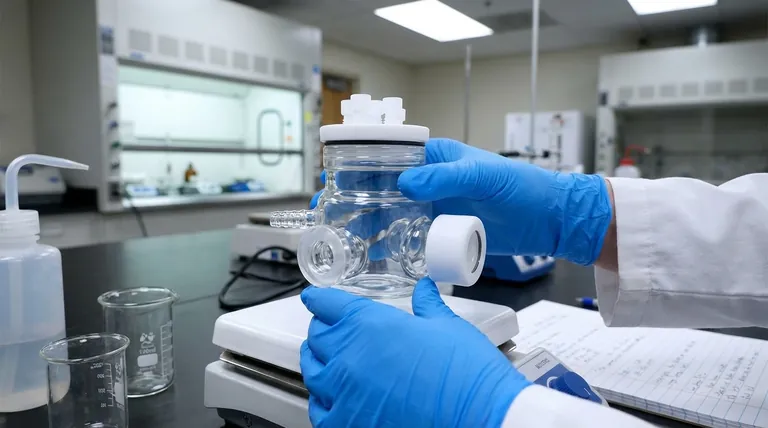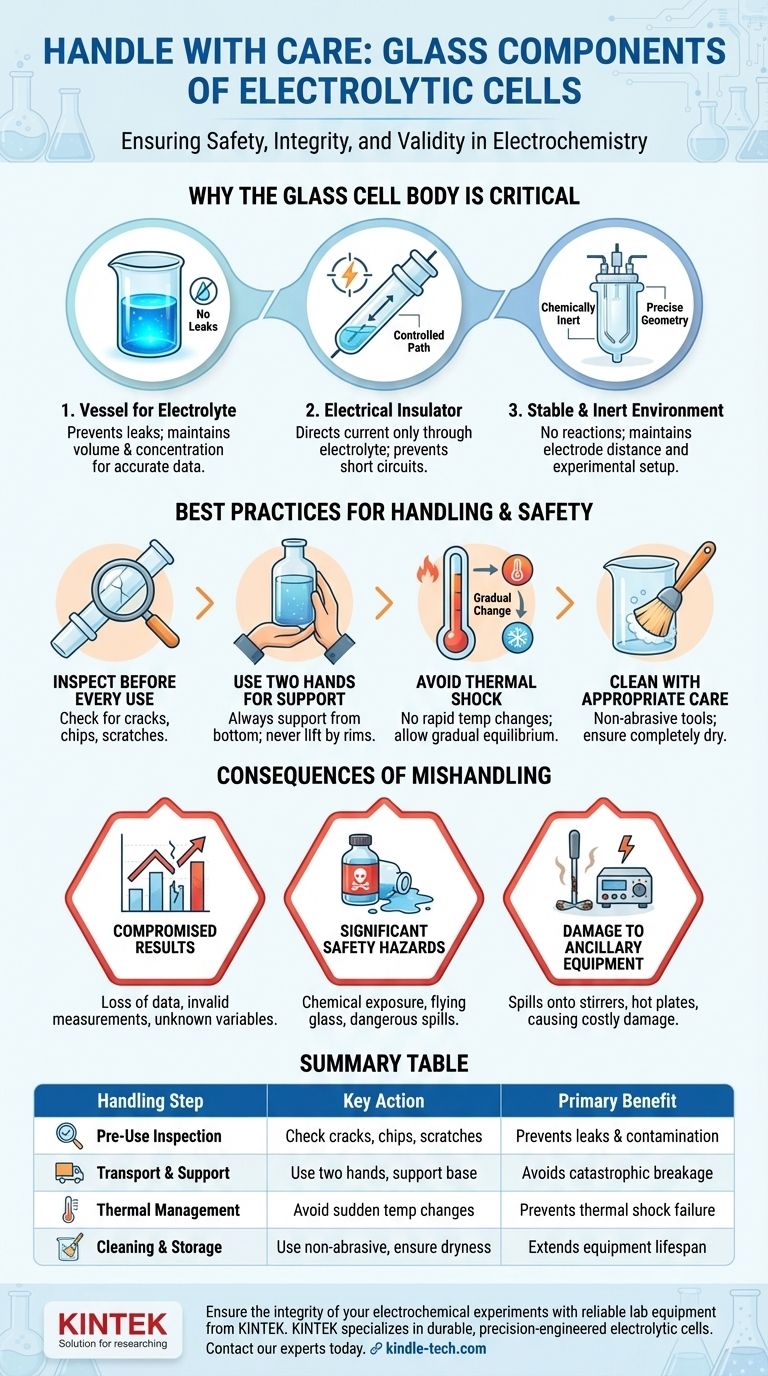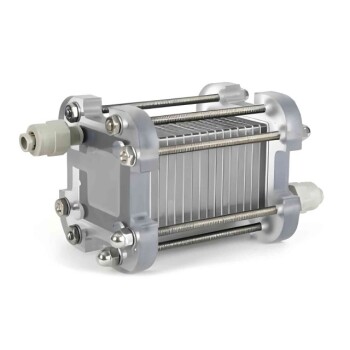At its core, handling the glass components of an electrolytic cell requires consistent, gentle care to prevent breakage. Because the glass body is the vessel that contains the entire electrochemical reaction, its physical integrity is not just a matter of preventing a mess—it is essential for the safety of the operator and the validity of the experiment.
The primary challenge is not just that glass is fragile, but that the electrolytic cell is a closed system. Any breach, from a microscopic crack to a full break, compromises the experiment by causing leaks, introducing contaminants, or creating safety hazards.

The Critical Role of the Glass Cell Body
Understanding why the glass is so important helps reinforce the need for careful handling. The cell body is not merely a container; it is an active component of the experimental setup.
A Vessel for the Electrolyte
The most obvious function of the cell is to hold the electrolyte—the ion-conducting solution or molten salt. The glass must be a perfect, non-reactive barrier.
A leak, no matter how small, can alter the volume and concentration of the electrolyte, rendering any quantitative measurements inaccurate.
An Electrical Insulator
Glass is an excellent electrical insulator. This property ensures that the only path for the current is through the electrolyte between the anode and cathode.
This controlled path is fundamental to electrolysis. A crack that becomes wet with electrolyte could create an unintended short circuit, completely disrupting the experiment.
A Stable and Inert Environment
The glass provides a chemically inert environment that does not react with the electrolyte or the products of the reaction.
It also maintains the precise geometry of the setup, including the distance between the electrodes, which is a critical variable in many electrochemical studies.
Best Practices for Handling and Safety
Moving beyond simple "be careful," a systematic approach to handling minimizes risk and ensures the longevity of the equipment.
Inspect Before Every Use
Before assembling your cell, perform a careful visual inspection. Look for hairline cracks, chips, or scratches, paying close attention to the joints, ports, and the base.
Running a gloved finger lightly over the surface can sometimes reveal fine cracks that are difficult to see.
Use Two Hands for Support
Never lift or carry the cell by a fragile rim or side arm. Always support its weight from the bottom with one hand while using your other hand to steady the body. This is especially critical when the cell is filled.
Avoid Thermal Shock
Rapid temperature changes are a primary cause of glassware failure. Never pour a hot solution into a cold cell or place a hot cell onto a cold surface. Allow the components to reach thermal equilibrium gradually.
Clean with Appropriate Care
Use non-abrasive, soft-bristled brushes for cleaning to avoid scratching the interior surfaces. A scratch is a weak point that can develop into a crack over time. Ensure the glass is completely dry before storage.
The Consequences of Mishandling
Understanding the specific failure modes underscores the importance of proper handling. A mistake can have cascading consequences beyond just a broken piece of glass.
Compromised Experimental Results
The most immediate consequence of a damaged cell is the loss of data. A leak invalidates concentration-dependent measurements, and contamination from a fracture can introduce unknown variables into your reaction.
Significant Safety Hazards
Many electrolytes are corrosive, toxic, or acidic. A leak poses a direct chemical exposure risk. A catastrophic break can result in flying glass shards and a dangerous chemical spill.
Damage to Ancillary Equipment
A leaking electrolytic cell can spill chemicals onto a magnetic stirrer, hot plate, or the external power supply. This can cause corrosion, short circuits, and costly damage to surrounding lab equipment.
Applying This to Your Work
Your approach to handling should be guided by your primary objective for the experiment.
- If your primary focus is accurate quantitative data: Your most critical step is a thorough pre-use inspection for any micro-cracks or chips that could cause imperceptible leaks.
- If your primary focus is safety: Proper two-handed support during transport and a strict avoidance of thermal shock are the most effective ways to prevent catastrophic failure.
- If your primary focus is equipment longevity: Gentle, non-abrasive cleaning and careful storage are essential to prevent the cumulative damage that leads to premature failure.
Ultimately, treating the cell with deliberate care is the foundation of safe and reliable electrochemistry.
Summary Table:
| Handling Step | Key Action | Primary Benefit |
|---|---|---|
| Pre-Use Inspection | Check for cracks, chips, and scratches. | Prevents leaks and contamination. |
| Transport & Support | Always use two hands, supporting the base. | Avoids catastrophic breakage. |
| Thermal Management | Avoid sudden temperature changes. | Prevents thermal shock failure. |
| Cleaning & Storage | Use non-abrasive tools; ensure dryness. | Extends equipment lifespan. |
Ensure the integrity of your electrochemical experiments with reliable lab equipment from KINTEK.
Proper handling is crucial, but it starts with quality glassware. KINTEK specializes in durable, precision-engineered electrolytic cells and lab equipment designed for safety and accuracy. Our products help you prevent leaks, avoid contamination, and protect your valuable research.
Contact our experts today to find the perfect electrolytic cell for your laboratory's specific needs and discover how we can support your work with dependable consumables and equipment.
Visual Guide

Related Products
- H-Type Double-Layer Optical Electrolytic Electrochemical Cell with Water Bath
- Quartz Electrolytic Electrochemical Cell for Electrochemical Experiments
- Electrolytic Electrochemical Cell for Coating Evaluation
- Double Layer Five-Port Water Bath Electrolytic Electrochemical Cell
- Thin-Layer Spectral Electrolysis Electrochemical Cell
People Also Ask
- What are the typical volumes and aperture configurations for a double-layer water-bath electrolytic cell? Optimize Your Electrochemical Setup
- What is a double-layer water-bath electrolytic cell? Achieve Precise Temperature Control for Your Electrolysis
- What is the purpose of the double-layer design in the electrolytic cell? Achieve Precise Temperature Control for Your Reactions
- What is the structure of an H-type exchangeable membrane electrolytic cell? A Guide to Precise Electrochemical Separation
- What is a H type cell? A Guide to Divided Electrochemical Cells for Accurate Experiments



















